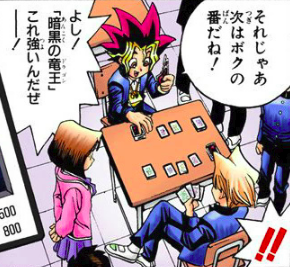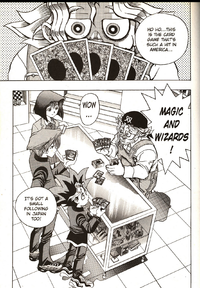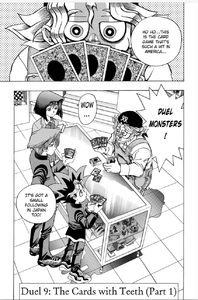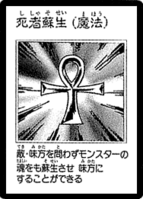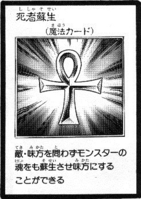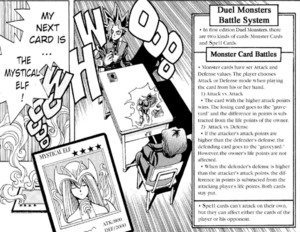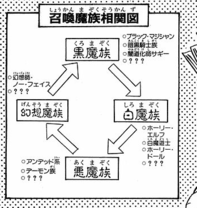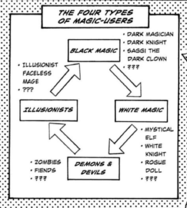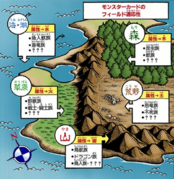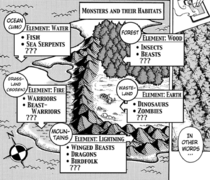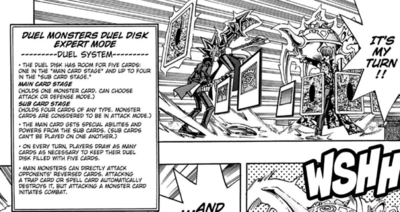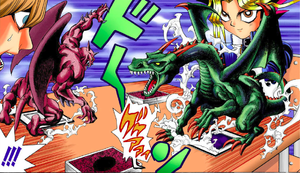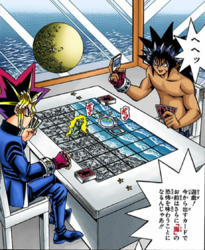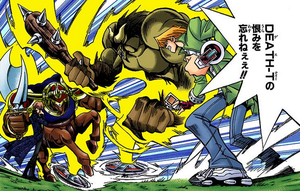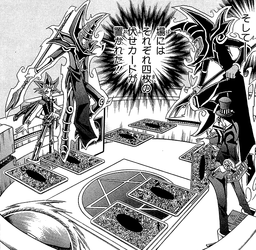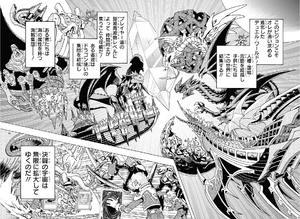Difference between revisions of "Duel Monsters (manga)"
m (→Egyptian Diaha) |
(→Name: Volume 2 with the gold rim on the cover calls it Magic and Wizards. The one with the yellow rim calls it Duel Monsters.) |
||
| Line 12: | Line 12: | ||
The game is called ''Magic & Wizards'' or ''M&W'' for short in the Japanese manga. However, due to its similarity to ''[[wikipedia:Magic: The Gathering|Magic: The Gathering]]'', the game was renamed to ''Duel Monsters'' in other media. Despite this, the Japanese manga continued to call the game ''Magic & Wizards'' throughout its run. | The game is called ''Magic & Wizards'' or ''M&W'' for short in the Japanese manga. However, due to its similarity to ''[[wikipedia:Magic: The Gathering|Magic: The Gathering]]'', the game was renamed to ''Duel Monsters'' in other media. Despite this, the Japanese manga continued to call the game ''Magic & Wizards'' throughout its run. | ||
| − | When the English manga was first printed in the ''[[Shonen Jump]]'' magazine, it used the name ''Magic and Wizards''.<ref name="d 9">{{chapter|Yu-Gi-Oh!|9|ref}}</ref> | + | When the English manga was first printed in the ''[[Shonen Jump]]'' magazine, it used the name ''Magic and Wizards''.<ref name="d 9">{{chapter|Yu-Gi-Oh!|9|ref}}</ref> This name was also used in the first printing of the graphic novels. In subsequent reprints, the name was changed to ''Duel Monsters''. |
<gallery widths="200" heights="300"> | <gallery widths="200" heights="300"> | ||
Revision as of 00:49, 19 October 2023
Duel Monsters, known as Magic & Wizards (マジック
This is the very first incarnation of Duel Monsters and served as the basis for many of the variations to follow, including the Yu-Gi-Oh! Official Card Game and Yu-Gi-Oh! Trading Card Game.
Duel Monsters debuted when the manga had an episodic format and featured a different game nearly every week. However due to its popularity among readers, it ended up becoming the main game played throughout the series.
In-universe, Duel Monsters was invented by Maximillion J. Pegasus, as a means of reintroducing Diaha, battles played in ancient Egypt using monsters sealed in stone slabs, to the modern world.
Contents
Name
The game is called Magic & Wizards or M&W for short in the Japanese manga. However, due to its similarity to Magic: The Gathering, the game was renamed to Duel Monsters in other media. Despite this, the Japanese manga continued to call the game Magic & Wizards throughout its run.
When the English manga was first printed in the Shonen Jump magazine, it used the name Magic and Wizards.[1] This name was also used in the first printing of the graphic novels. In subsequent reprints, the name was changed to Duel Monsters.
Cards
Layout
The layout of the cards is simplistic compared to other iterations of the game. All cards are white with black border around them. While concepts like Attribute and Type exist, they are not reflected on the card's layout. Sometimes cards have effects not printed on them, such as "Time Wizard".
The rules on the placement of elements on a card are not strictly enforced. The rules below are generally followed, but numerous exceptions exist.
Initially the layout consisted of the following in this order:
- The card name
- For non-Monster Cards, the card's type appeared in brackets after the name. This did not include the word "Card". e.g. a Spell Card would say "(Spell)", not "(Spell Card)".
- For Monster Cards, a number of stars indicating the Level appeared on the same row as the name or the next row, depending on space.
- The card's artwork, surrounded by a border.
- For Monster Cards, a row with the word "ATK" (
攻 撃 力 ), followed by the ATK value and a row with the word "DEF" (守 備 力 ), followed by the DEF value. - Text for the card's effect
- If a Monster Card has an effect, its ATK and DEF are put on the same row, making space for the effect to be printed above them.
- Card's have a prismatic corner stamp, but these are not visible to the reader.[1]
Beginning with Yu-Gi-Oh! Duel 60 (Duelist Duel 1): "Challenge!!", the layout changed a bit:
- The word "Card" appears after the card type. e.g. "(Spell Card)". The card type is completely omitted for a number of cards.
- Level and card type are more frequently placed on the line after the name.
- On Monster Cards, the card's effect is placed above ATK and DEF.
Attributes
The game includes the following Attributes:
- Black Magic[2]
- White Magic[2]
- Demon Magic (called "Fiend" in one instance in the English manga[3] and split into "Demon" and "Devil" in another[2])
- Illusion Magic (called "Illusionist" in the English manga)[2]
- Earth[4]
- Lightning[4]
- Water[4]
- Fire[4]
- Wood[4]
- Light[5]
- Dark[6]
- God
Types
The game includes the following Types:
- Dragon[4]
- Zombie[4]
- Warrior[4]
- Beast-Warrior[4]
- Beast[4]
- Winged Beast[4]
- Insect[4]
- Dinosaur[4]
- Fish[4]
- Sea Serpent[4]
- Birdfolk[4]
- Magical Knight (called Warrior in the English manga)[6]
God-Beast has also been mentioned in the context of the Egyptian Gods, without specifically mentioning "Type".[7]
Rules
Basic
The following rules were used in Duel Monsters first appearance and Death-T.
The English translation retroactively referred to these rules as "first edition Duel Monsters", as it was printed after later versions of the rules had been featured.
- There are two players in each Duel.[1]
- Each player makes a Deck using 40 cards.[1] The Decks are shuffled before a Duel.[8]
- There are two kinds of cards; Monster Cards and Spell Cards.[3]
- Each player starts with 2000 Life Points. If a player runs out of Life Points they lose.[1]
- At the beginning of a Duel, each player draws five cards, which become their hand.[6]
- The players take turns. Each turn the turn player draws one card from their Deck.[1]
- The turn player can Summon cards from their hand in Attack or Defense Mode.[1] Attack Mode is vertical. Defense Mode is horizontal.[3]
- The turn player can attack with Attack Mode monsters.[3]
- If an Attack Mode monster battles another Attack Mode monster, the monster with the lower ATK is destroyed and its controller loses Life Points equal to the difference.[3]
- When Attack Mode monsters with equal ATK battle, both are destroyed.
- If an Attack Mode monster attacks a Defense Mode monster and its ATK is higher than the defending monster's DEF, the defending monster is destroyed and no Life Points are lost.[3]
- If an Attack Mode monster attacks a Defense Mode monster and its ATK is lower than the defending monster's DEF, neither monster is destroyed and the controller of the attacking monster loses Life Points equal to the difference in the ATK and DEF.[3]
- If a player does not have a monster to defend from their opponent's monsters attack, the monster's ATK is deducted from the defenseless player's Life Points.[1]
- Destroyed cards go to the Graveyard.[3]
- The turn player can activate Spell Cards from their hand.[6]
- Spell Cards cannot battle, but can be used to affect other cards or the players.[3]
- Spell Cards can be played face-down on the field until they are ready to be used.[3]
- Monsters with the power of flight have a 35% chance to evade ground-based attacks, allowing them to avoid being destroyed when battling monsters with the same ATK.[6]
Standard
The Standard rules contained the basic rules, with some additional ones. These were used during the Japanese National Duel Monsters Championship and the Duelist Kingdom tournament.
- More types of cards were added, including Equip,[9] Trap[10], Illusion[2] and Virus.[11]
- Trap Cards can be activated during either players' turn in response to certain actions.
- Virus Cards are used to destroy cards in the opponent's Deck using a virus.[12]
- Monsters were divided into Monster and Magic-User Cards.[13] This distinction is rarely mentioned.
- Monsters and Magic-Users have Attributes, each with strengths and weaknesses.[13]
- The Attributes of Magic-Users are Black Magic, White Magic, Demon Magic (called "Demons & Devils" in the English manga) and Illusion Magic (called "Illusionists" in the English manga). Black Magic is strong against White Magic, White Magic is strong against Demon Magic, Demon Magic is strong against Illusion Magic, Illusion Magic is strong against Black Magic.[2]
- Other Attributes include Earth, Lightning, Water, Fire, Wood,[4] Light[14] and Dark.[6] Lightning is strong against Water.[13]
- What happens when monster of opposing Attributes battle is inconsistent. Sometimes the monster of the weaker Attribute loses half its ATK.[13] More often, nothing happens.
- On the Duelist Kingdom island, monsters received Field Power Sources depending on the terrain they were played in.[15]Field Power Sources being explained, in Japanese and English
(Attribute属 性 is localized as "Element" in this instance.)- Forest strengthens the Wood Attribute and the Insect and Beast Types.[4]
- Grassland strengthens the Fire Attribute and the Warrior and Beast-Warrior Types.[4]
- Mountains strengthens the Lightning Attribute and the Winged Beast, Dragon and Birdfolk Types.[4]
- Wasteland strengthened the Earth Attribute and the Dinosaur and Zombie Types.[4]
- Ocean strengthened the Water Attribute and the Fish and Sea Serpent Types.[4]
- Graveyard strengthened the Zombie Type.[16]
- Monsters can be played in face-down Attack Mode.[13] However, this is rarely done.
- Monsters can be fused together using the card "Polymerization".[17] "Polymerization" and the Fusion Material monsters are still in play after a Fusion. The Fusion Monster does not have a physical card.[18]
- Ritual Spell Cards can be used to Ritual Summon a monster by sacrificing monsters that meet a certain criteria.[19]
Expert
The Expert rules were used with the first version Duel Disks. This alters many of the previous rules and adds more.
- Each player can only hold five cards at a time.[18]
- If a player has five cards at the start of their turn, they cannot draw a card.[18]
- If a player has feer than five cards at the start of their turn, they draw until they have five.
- The Duel Disk contains five stages; the main card stage and four sub card stages. The main card is played in the main stage. All the player's other cards in their hand are played in the sub stages.[12]
- Monsters in the main monster can be played in Attack or Defense Mode. Monsters in the sub stages are all in Attack Mode.[12]
- The main card gets special abilities and powers from the sub cards.[12]
- Sub cards are face-down until used or attacked.[12]
- Sub cards can be flipped face-down and shuffled.[12]
- A player's main monster can attack their opponent's main monster or any of the opponent's face-down cards. Normal rules of battle are applied if they attack a Monster Card. Non-Monster Cards are automatically destroyed if they are attacked.[12]
Super Expert
The Super Expert rules were introduced in the Battle City tournament. They are based on the standard rules, contain additional rules and alter previous ones. The Expert rules do not apply in Super Expert.
- Each player starts with 4000 Life Points.[20]
- A player's hand cannot contain more than seven cards[20]
- High Level monsters require sacrifices to be Summoned.
Realistic projections of cards
Multiple methods have been used to create lifelike projections of the cards while playing Duel Monsters.
- Cards have been brought to life by Millennium Item holders through use of Shadow Games.
- KaibaCorp used holographic technology to create projections of cards to artificially replicate the experience of the Shadow Games. This was mainly done through the use of Virtual Simulation Battle Boxes.
- KaibaCorp later invented Solid Vision, which created even more realistic and life-sized projections of the cards. And invented Duel Disks as as a means of creating the projections from cards.
- KaibaCorp also invented the Neurons as a means of playing Duel Monsters in the Duel Links virtual reality.
Monsters in a Shadow Game
Holograms in a Virtual Simulation Battle Box
Solid Vision projections from the prototype Duel Disks
Virtual reality created using Neurons
History
Egyptian Diaha
In ancient Egypt, it was believed that misfortunes were caused by evil spirits dwelling inside people. In order to bring peace, the Pharaoh's magicians tamed such spirits, gave them names and physical forms, and trapped them in stone slabs. While sealed the monsters slowly became more powerful. Eventually a group of Priests acted against the Pharaoh and harnessed the power of the stone slabs, using them to and summon the monsters from the tablets to fight in battles, known as Diaha.[21]
The magicians eventually died out and the stone tablets fell asleep deep below the earth. The legend was recorded in the Book of Thoth and passed down from generation to generation. All card games were said to have sprang from this source.[22]
Creation
Maximillion J. Pegasus became interested in the ancient Egyptian beliefs in life after death, following the death of his lover, Cyndia. This led him to Egypt to learn more.[23]
At the village, Kul Elna, Pegasus failed to bargain with Shadi for the safety of a a thief who was to persecuted for his attempt to steal the Millennium Ring. Pegasus spied on the thief being put on trial to see if he was chosen by the Ring. However the Ring rejected the thief as a host, burning him to death in the process. Pegasus was caught spying on the ritual and not permitted to leave unless he became bearer of a Millennium Item. For his trial, Pegasus had his left eye was cut out and the Millennium Eye inserted into in its socket. The Eye accepted Pegasus and showed him an apparition of Cyndia.[23]
In the Valley of the Kings, Pegasus heard the legends of the Egyptian magicians that battled using the monsters sealed in tablets. He created Duel Monsters as a means of bringing the ancient games to the modern world,[22] an act Ishizu Ishtar claimed he was led by fate to do.[7]
Pegasus based a number of cards on images he saw on stone carvings. This included the three Hidden Gods of Egypt depicted on the Tablet of Lost Memories, each of which he designed as a one-of-a-kind card. It was said that whoever acquires the three God cards would be given the title of "Duel King". However the cards gained great power as if the Gods actually resided in them and were capable of taking an opponent's life. Pegasus regretted their creation, considering it to be his greatest mistake. He tried to physically destroy the cards, but could not bring himself to do it, and opted to have them buried within the Valley of the Kings, where they had come from.[7]
The card "Blue-Eyes White Dragon" was based on The White Dragon seen on the Tablet of Lost Memories.[7] It was initially considered to be one of the most powerful cards, so overpowered that production was ceased, causing it to gain a high monetary among collectors.[1] Four copies were known to exist. They fell into the hands of collectors in the United States, Germany, and Hong Kong and Sugoroku Mutou in Japan.[24]
Duel Monsters became a huge success in the United States, with players said to be in excess of twenty million and many tournaments hosted with large prizes.[25] The game features a number of valuable cards, with one fan in America alleged to have sold his house to pay for a single card.[1]
Introduction of holograms
Seto Kaiba's attempt to steal the "Blue-Eyes White Dragon" from Sugoroku Mutou resulted in him being challenged to a Shadow Game of Duel Monsters by Dark Yugi. In this game, the monsters came to life as they were Summoned.[1] On defeat, Kaiba was subjected to a Penalty Game, resulting in him imagining he was trapped inside a card, causing him to reside in the World of Duel Monsters, where he suffered the Experience of Death at the hands of monsters.[3]
Kaiba invented the Virtual Simulation Battle Boxes, which created 3-D holograms of cards, as players played Duel Monsters, recreating what he witnessed in the Shadow Game. And allowed him to inflict a reconstruction of the Experience of Death on the loser.[24]
Kaiba's company, KaibaCorp, sent an offer to Pegasus to develop Virtual Simulation Battle Boxes together with Industrial Illusions, to enhance the experience of playing Duel Monsters. Pegasus described it as a great and said that he would love for their companies to develop it together.[25]
Battle Boxes were used during Death-T and Duelist Kingdom.
Introduction of Solid Vision
Duel Disks were developed later by KaibaCorp as a more upgraded means of Dueling that the Battle Boxes. Kaiba was in some part incentivized to develop them having witnessed the mind-reading abilities that the Millennium Eye granted Pegasus. The Duel Disks required players to stand at least 5 meters apart, which Kaiba hoped would be enough to put him out of Pegasus' Mind Scan's range. Unlike Battle Boxes the Duel Disks used Solid Vision, which created life-sized projections[26] and were considered to be much more realistic than the holograms used by the Battle Boxes.[27]
Pegasus was fond of the Solid Vision technology as it was capable of creating projections that were more lifelike than simple holograms. He hoped to takeover KaibaCorp, so he could have the technology and make it even more lifelike and create a realistic reconstruction of Cyndia, whom he had created a card of.[27]
References
- ↑ a b c d e f g h i j k Yu-Gi-Oh! Duel 9: "The Cards with Teeth (Part 1)"
- ↑ a b c d e f Yu-Gi-Oh! Duel 62 (Duelist Duel 3): "Countdown!!"
- ↑ a b c d e f g h i j k Yu-Gi-Oh! Duel 10: "The Cards with Teeth (Part 2)"
- ↑ a b c d e f g h i j k l m n o p q r s t u v Yu-Gi-Oh! Duel 66 (Duelist Duel 7): "The Trap"
- ↑ Yu-Gi-Oh! Duel 110 (Duelist Duel 51): "Toons Attack!"
- ↑ a b c d e f Yu-Gi-Oh! Duel 37: "To the Death!!"
- ↑ a b c d Yu-Gi-Oh! Duel 147 (Duelist Duel 88): "The Lost Cards"
- ↑ Yu-Gi-Oh! Duel 36: "Battle Beyond Hope"
- ↑ Yu-Gi-Oh! Duel 70 (Duelist Duel 11): "Things that Don't Change"
- ↑ Yu-Gi-Oh! Duel 60 (Duelist Duel 1): "Challenge!!"
- ↑ Yu-Gi-Oh! Duel 110 (Duelist Duel 51): "Toons Attack!"
- ↑ a b c d e f g Yu-Gi-Oh! Duel 102 (Duelist Duel 43): "A Close Fight!"
- ↑ a b c d e Yu-Gi-Oh! Duel 61 (Duelist Duel 2): "Don't Draw That Card!!"
- ↑ Yu-Gi-Oh! Duel 110 (Duelist Duel 51): "Toons Attack!"
- ↑ Yu-Gi-Oh! Duel 65 (Duelist Duel 6): "Let the Duel Begin!"
- ↑ Yu-Gi-Oh! Duel 89 (Duelist Duel 30): "Duel Without End"
- ↑ Yu-Gi-Oh! Duel 68 (Duelist Duel 9): "Demon Lightning"
- ↑ a b c Yu-Gi-Oh! Duel 105 (Duelist Duel 46): "No Mercy"
- ↑ Yu-Gi-Oh! Duel 108 (Duelist Duel 49): "The First Stages of Fear!"
- ↑ a b c d Yu-Gi-Oh! Duel 153 (Duelist Duel 94): "Duel of Vengeance!"
- ↑ Yu-Gi-Oh! Duel 146 (Duelist Duel 87): "The Ancient Stone"
- ↑ a b Yu-Gi-Oh! Duel 129 (Duelist Duel 70): "The Sacrifice!"
- ↑ a b Yu-Gi-Oh! Duel 132 (Duelist Duel 73): "The Tragic Tale of the Millennium Eye"
- ↑ a b Yu-Gi-Oh! Duel 27: "Project Start!"
- ↑ a b Yu-Gi-Oh! Duel 87 (Duelist Duel 28): "The Terror of Pegasus!"
- ↑ Yu-Gi-Oh! Duel 85 (Duelist Duel 26): "Duelist's Honor"
- ↑ a b Yu-Gi-Oh! Duel 133 (Duelist Duel 74): "The Precious Piece"
